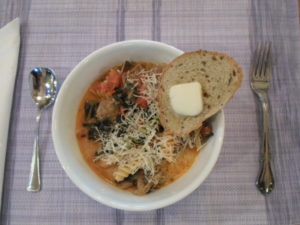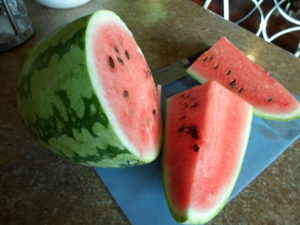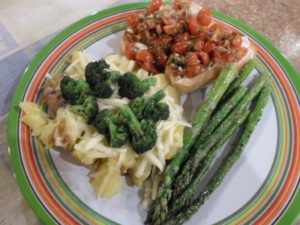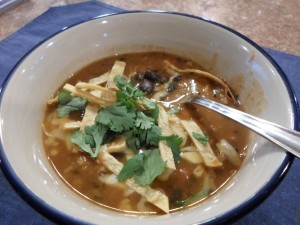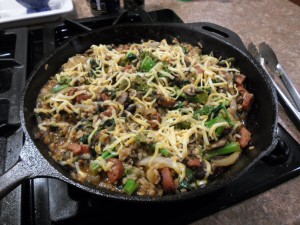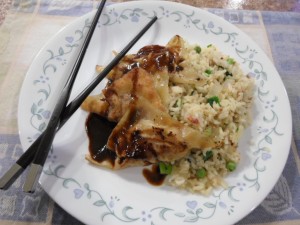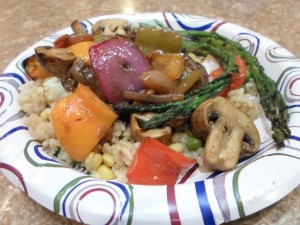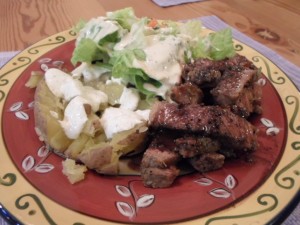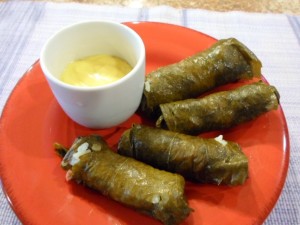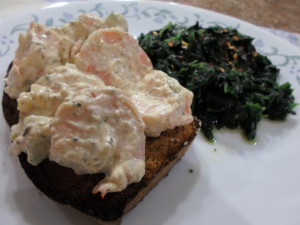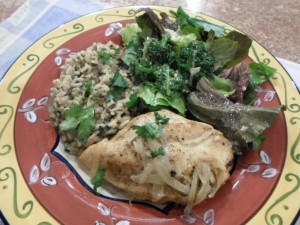I spent Sunday afternoon racking and running new wine through a coarse filter. The juice will undergo a cold-stabilization period before it will be blended and bottled. The process took hours and it was close to 8:30 when I started dinner and watched the football game. Sounds like the fourth quarter was the time to watch, anyway.
With the unseasonably warm weather, stew doesn’t sound too inviting. Fortunately, Saturday was cool when I tried this hearty, healthy stew.
Italian Sausage Stew
1 lb. Italian sausage links
1-1/2 c. onions, chopped
1 c. green peppers, chopped
2 tsp. garlic, minced
28-oz. canned tomatoes
1 c. mushrooms, sliced
2 Tbsp. butter
5-6 c. torn kale, washed and stems removed
10 oz. wheat penne pasta
3-4 c. chicken stock
1 c. half-and-half
salt and pepper, to taste
Brown Italian sausage links on all sides in a large pot. Remove and reserve for later. They won’t be cooked through, but will finish cooking later.
Using the sausage grease, sauté onions and green peppers for 15-20 minutes. Add a pinch of salt and pepper. Add garlic and cook for a couple of minutes. Add canned tomatoes, reduce heat and simmer.
In another pot, brown mushrooms in butter. Add to the first pot. Add enough water to the empty pot to blanch the kale. Bring the water to a boil and season with salt. Tear the kale into bite-sized pieces. Add to the boiling water and cook for 5 minutes. Remove kale with a slotted spoon and add to the first pot. Do not throw out that water! Instead, bring it back up to a boil and cook the penne pasta, following the package directions.
When the penne is ready, drain it and add it to the first pot. Add enough chicken stock to the first pot to make a stew-like consistency. Simmer for 10-15 minutes, then remove from the heat. Add half-and-half and season with salt and pepper.
Serve garnished with grated Parmesan cheese and/or chopped fresh parsley.
Stew is perfect when there’s time to cook. However, when I need something quick and hearty, I make an easy soup using canned peas.
Quick Pea Soup
1 onion, chopped
2 cloves garlic, minced
2 tsp. freshly grated ginger
1 Tbsp. coconut oil
4 cans spring peas or baby peas
4 c. chicken stock
1 c. fat-free half-and-half
salt and pepper, to taste
Sauté onions, garlic and ginger in coconut oil in a pot with a pinch of salt and pepper. Drain peas, and add to the pot along with the chicken stock. Bring to a boil and reduce the heat. Simmer for 15 minutes and remove from the heat.
For perfectly smooth pea soup, puree all of the soup in a food processor or with an immersion blender. I like to see some recognizable peas, so I skim out about a cup of peas, puree what’s in the pot, and then add the peas in the cup back to the pot.
Add fat-free half-and-half and adjust seasonings. Garnish with crumbled cooked bacon or cubes of cooked ham.
Years ago, experts insisted that coconut oil was bad for us. Now, experts are stating that it is good. So, I suggest trying coconut oil while it’s still considered to be good. I like the taste, even in savory dishes. I’m pretty sure ginger has always been healthy, and of course so are peas, making the Quick Pea Soup a terrific choice.

